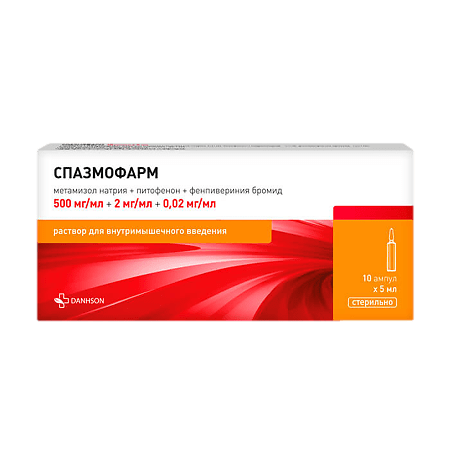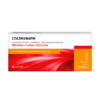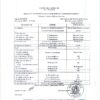No products in the cart.
Spasmopharm, 500 mg+2 mg+0.02 mg/ml 5 ml 10 pcs
€1.00
Out of stock
(E-mail when Stock is available)
Description
Spasmopharm is a combined medicine with pronounced antispasmodic and analgesic activity.
Sodium metamizole has pronounced analgesic and antipyretic effect in combination with less pronounced anti-inflammatory and antispasmodic activity. Its action is caused by inhibition of the synthesis of prostaglandins and endogenous algogens by increasing the threshold of excitability in the thalamus by influence on the hypothalamus and the formation of endogenous pyrogens.
Phenpiperinia bromide has a moderate m-cholinoblocking effect reduces the tone and motility of the smooth muscles of the stomach intestinal bile and urinary tract.
Pitophenone has a papaverine-like effect on the smooth muscles of blood vessels and internal organs with a pronounced antispasmodic effect.
Pharmacokinetics:
Absorption. After intramuscular administration, sodium metamizole is rapidly absorbed. The systemic bioavailability of sodium metamizole is about 85%.
Distribution. Binding to plasma proteins of sodium metamizole is 50-60%. It penetrates through the blood-brain and placental barriers. Volume of distribution is about 07 l / kg.
Pitophenone and phenpiperinia bromide do not penetrate through the blood-brain barrier.
Metabolism. Sodium metamizole undergoes intensive biotransformation in the liver. Its main metabolite 4-methyl-amino-antipyrine (MAA) is metabolized in the liver to form other metabolites including pharmacologically active 4-amino-antipyrine (AA). Maximum plasma concentrations (of all metabolites) are reached after approximately 30-90 minutes.
The four major metabolites of sodium metamizole are:
4-methylaminoantipyrine (MAA) active; 4-aminoantipyrine (AA) active; 4-formylaminoantipyrine (FAA) inactive; 4-acetylaminoantipyrine (AAA) inactive.
Pitophenone and phenpiperinia bromide are metabolized in the liver primarily by oxidation.
Extraction. Metamizole sodium is excreted by the kidneys as metabolites about 3% – unchanged. Elimination half-life is about 10 hours. In therapeutic concentrations it penetrates into breast milk. The elimination half-life of pitophenone and phenpiperinia bromide is about 10 hours.
Almost 90% of pythophenone and phenpiperinia bromide are excreted by the kidneys as metabolites and 10% through the intestine unchanged.
Patients with impaired liver function. The half-life of MAA (active metabolite) in patients with liver dysfunction is increased approximately 3-fold. It is recommended that the dose be reduced in these patients.
Patients with impaired renal function. In patients with impaired renal function a decrease in elimination of some metabolites is observed. It is recommended to reduce the dose in such patients.
Indications
Indications
Active ingredient
Active ingredient
How to take, the dosage
How to take, the dosage
The drug is to be administered strictly intramuscularly!
The drug is intended for short-term use!
The drug must be administered under the close supervision of a physician with emergency treatment options due to the risk of anaphylactic shock in patients with hypersensitivity to sodium metamizole or pyrazolone derivatives.
Adults and children over 15 years of age (>53 kg)
In adults and children over 15 years of age the drug is administered intramuscularly in 2-5 ml. If necessary, the dose is repeated after 6-8 hours. The maximum daily dose should not exceed 6 ml of the drug (equivalent to 3 g of sodium metamizole).
The duration of treatment is 2-3 days.
After therapeutic effect is achieved, it is allowed to switch to treatment with oral analgesics and antispasmodics.
If there is no therapeutic effect, treatment is stopped.
Patients over 65 years of age
Dose reduction is usually not necessary. In patients with age-related hepatic and renal impairment the dose must be reduced because the elimination half-life of sodium metamizole metabolites may be increased (see section “Pharmacokinetics”).
Patients with impaired renal function
Sodium metamizole is excreted in the urine as metabolites. In patients with mild to moderate renal impairment, half the adult dose is recommended.
Patients with hepatic impairment
The elimination half-life of active metabolites of sodium metamizole is increased in such patients. High doses should be avoided in patients with hepatic impairment. There is no need to reduce the dose in short-term use.
There is insufficient experience with long-term use in patients with renal or hepatic impairment.
Children
The drug is contraindicated in children under the age of 15 years (see Contraindications section).
Interaction
Interaction
Combination of SPASMOFARM with other medicinal products requires special caution due to the content of sodium metamizole, which is an inducer of microsomal liver enzymes.
Indirect anticoagulants
In concomitant use, sodium metamizole may decrease the activity of coumarin anticoagulants due to induction of hepatic microsomal enzymes.
Chlorpromazine and other phenothiazine derivatives
In concomitant use with sodium metamizole there is a risk of severe hypothermia.
Cyclosporine A
Sodium metamizole decreases the plasma concentration of cyclosporine A when used concomitantly.
Chloramphenicol and other myelotoxic agents
There is an increased risk of myelosuppression when used concomitantly with sodium metamizole.
Enzyme inducers
The barbiturates glutethimide phenylbutazone may weaken the effects of sodium metamizole.
CNS depressants
CNS depressants may increase the analgesic effects of sodium metamizole.
Tricyclic antidepressants (imipramine amitriptyline) oral contraceptives analgesics allopurinol
Augmented effects when used with sodium metamizole.
Simultaneous use with other analgesics and NSAIDs increases the risk of hypersensitivity and other adverse reactions.
Pyrazolone derivatives can interact with captopril lithium methotrexate and triamterene and alter the effectiveness of hypotensive drugs diuretics. The magnitude of these interactions is unknown.
Special Instructions
Special Instructions
When treating with SPASMOFARM there is a risk of anaphylactic reactions. At the first signs of hypersensitivity the drug administration should be stopped and urgent therapeutic measures (epinephrine glucocorticosteroids antihistamines) should be taken.
The risk of anaphylactoid reactions when using sodium metamizole is significantly increased in patients with:
– Analgesic asthma syndrome or idiosyncrasy to analgesics in the form of angioedema urticaria;
– Bronchial asthma especially accompanied by rhinosinusitis and nasal mucosal polyposis;
– chronic urticaria;
– idiosyncrasy to dyes (e.g., tartrazine) and preservatives (e.g., benzoate);
– alcohol intolerance. Such patients react to the use of a minimal amount of alcoholic beverages with symptoms such as sneezing, lacrimation and severe visual impairment. Such intolerance to alcohol can be a sign of undiagnosed “aspirin” asthma syndrome.
Spasmopharm contains sodium metamizole, which has a small but life-threatening risk of shock and agranulocytosis. The development of agranulocytosis is independent of the dose and cannot be predicted. It can occur after the first dose or after multiple doses. Typical signs of agranulocytosis are fever, sore throat, painful swallowing, inflammation of the mucous membrane of the mouth, nose, pharynx, and anorectal genital area. In case of a sudden worsening of the general state and signs of agranulocytosis the drug should be discontinued immediately without waiting for laboratory confirmation.
When treating with SPASMOFARM patients with hematologic diseases or those with a history of such diseases, hematologic status should be monitored during treatment.
The drug should be used with caution in patients with obstructive diseases of the gastrointestinal tract (achalasia cardia pyloroduodenal stenosis). Repeated use of the drug SPAZMOFARM in these cases may cause delayed evacuation of gastrointestinal contents and intoxication. Administration of SPASMOFARM in patients with gastroesophageal reflux disease intestinal atony paralytic intestinal obstruction glaucoma myasthenia gravis heart disease (arrhythmias coronary heart disease chronic heart failure) requires special caution and medical supervision.
Sodium metamizole as a component of SPASMOFARM may cause hypotensive reactions (see section “Side effects”). These reactions are dose-dependent and more common with parenteral use.
The risk of these reactions is increased in the following cases:
– in patients with a history of arterial hypotension with decreased fluid volume and electrolyte content or dehydration unstable hemodynamics or circulatory insufficiency (e.g., patients with myocardial infarction or polytrauma);
– in patients with elevated body temperature.
In these patients, careful evaluation of the need for the drug and close monitoring may require therapeutic measures (e.g., circulatory stabilization) to reduce the risk of arterial hypotension. SPASMOFARM should only be used when carefully monitoring hemodynamics in patients who do not require mandatory forced lowering of blood pressure such as those with severe coronary heart disease or cerebral stenosis.
Spasmopharm should only be used after careful assessment of the benefit/risk ratio and appropriate precautions should be taken in patients with renal or hepatic impairment (see section “Dosage and administration”).
Phenpiperinia bromide has m-choline-blocking effects and may cause dizziness and impaired accommodation. Sodium metamizole may adversely affect the ability to concentrate and leads to decreased responsiveness.
Patients driving or operating machinery should be warned about possible adverse reactions to the drug. Activities requiring increased attention should be discontinued until the adverse reactions disappear.
Contraindications
Contraindications
Side effects
Side effects
Unwanted reactions are grouped by system and organ and frequency of occurrence:
Frequency gradation: very common (â¥1/10) common (â¥1/100 to <1/10) infrequent (â¥1/1000 to <1/100) rare (â¥1/10000 to <1/1000) very rare (<1/10000) frequency unknown (frequency cannot be determined based on available data).
The adverse reactions listed below are primarily due to the drug’s constituent sodium metamizole.
Hematological and lymphatic disorders
Rarely: leukopenia.
Very rare: agranulocytosis thrombocytopenia anemia (hemolytic anemia aplastic anemia).
The risk of agranulocytosis cannot be anticipated. Agranulocytosis may also occur in patients who have previously taken sodium metamizole without such adverse reactions.
Immune disorders:
Infrequent: limited exanthema.
Rarely: maculopapular rash anaphylactic or anaphylactoid reactions especially after parenteral administration.
These reactions may occur during administration of the drug or immediately after discontinuation of administration, but may also occur hours later. They usually develop within the first hour after injection. Milder reactions are manifested by typical skin and mucous membrane reactions (e.g. itching, burning, redness, urticaria swelling: local or general) dyspnea and less frequently by gastrointestinal complaints. Mild reactions may progress to more severe forms with generalized urticaria severe angioedema (including laryngospasm) to severe bronchospasm disturbance of heart rhythm decrease of blood pressure (sometimes with a preceding increase in blood pressure).
In this regard, if any skin reaction occurs, the use of the drug should be discontinued immediately.
Very rare: bronchial asthma attack (in patients with “aspirin” asthma) Stevens-Johnson syndrome Lyell syndrome circulatory shock.
Neurological disorders: dizziness headache.
Visual disorders: visual disturbances: accommodation disorders.
Cardiac disorders:
Infrequent: palpitations tachycardia heart rhythm disorders cyanosis.
Vascular disorders:
Infrequent: arterial hypotension.
Gastrointestinal disorders:
Prevalence unknown: dry mouth nausea vomiting abdominal pain and discomfort constipation exacerbation of gastritis and peptic ulcer disease in rare cases ulceration and vomiting with a mixture of blood.
Renal and urinary tract disorders:
Rarely: proteinuria oliguria anuria polyuria interstitial nephritis staining of urine red.
Prevalence unknown: urinary retention.
General disorders and disorders at the site of administration: in parenteral administration, pain at the site of administration and local reactions.
Overdose
Overdose
Pregnancy use
Pregnancy use
Pregnancy
The results of animal studies indicate that the drug has no embryotoxic and teratogenic potential. Strictly controlled studies in pregnant women have not yet been conducted. In spite of the fact that sodium metamizole is a weak inhibitor of prostaglandins synthesis the possibility of premature closure of the arterial (Botall’s) duct as well as perinatal complications due to decrease of fetal and maternal platelets aggregation cannot be excluded, therefore the drug usage during pregnancy is contraindicated.
Breast-feeding
Because metabolites of sodium metamizole are excreted with the breast milk, breast-feeding should be stopped if the drug must be used.
Similarities
Similarities
Additional information
| Shelf life | 5 years. Do not use after the expiration date. |
|---|---|
| Conditions of storage | Store at a temperature not exceeding 25 ° C. Store out of the reach of children. |
| Manufacturer | VetProm AD, Bulgaria |
| Medication form | solution for injection |
| Brand | VetProm AD |
Related products
Buy Spasmopharm, 500 mg+2 mg+0.02 mg/ml 5 ml 10 pcs with delivery to USA, UK, Europe and over 120 other countries.





















